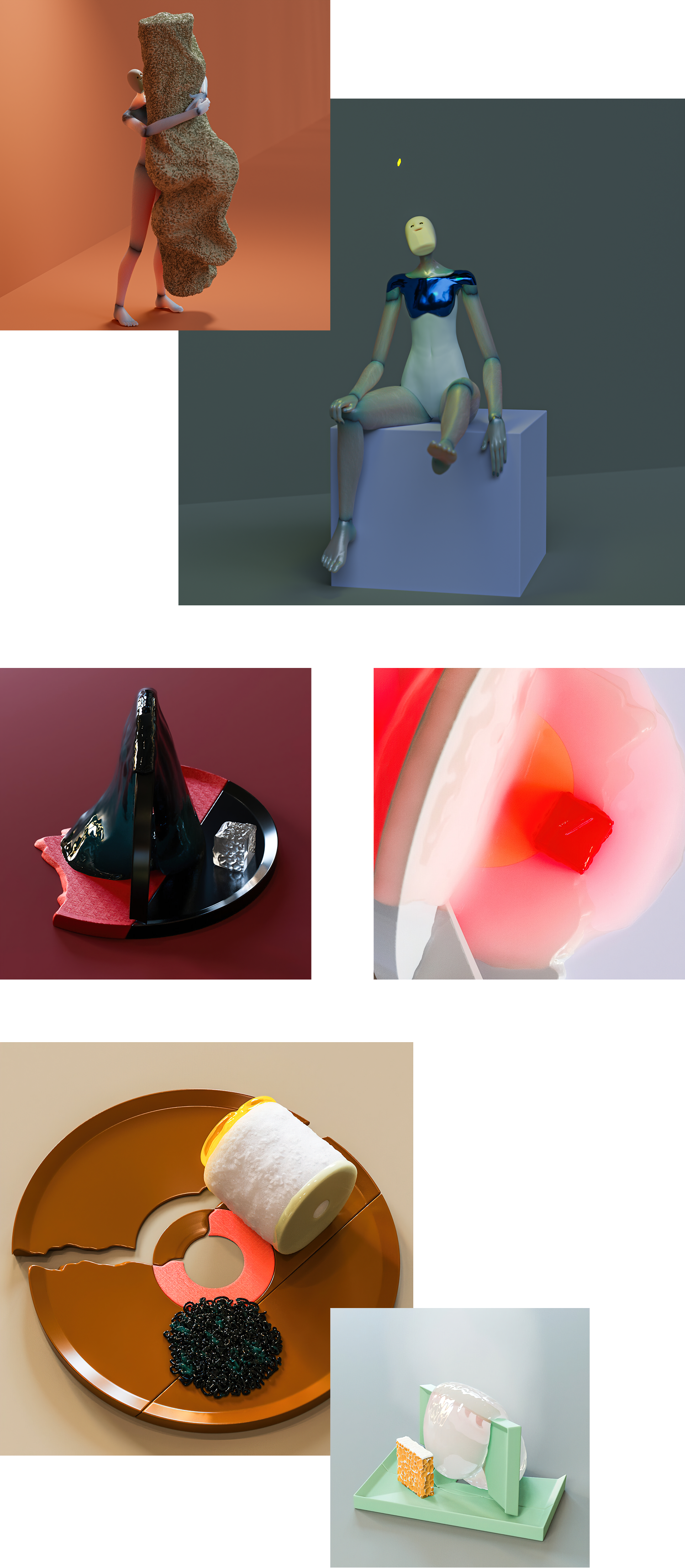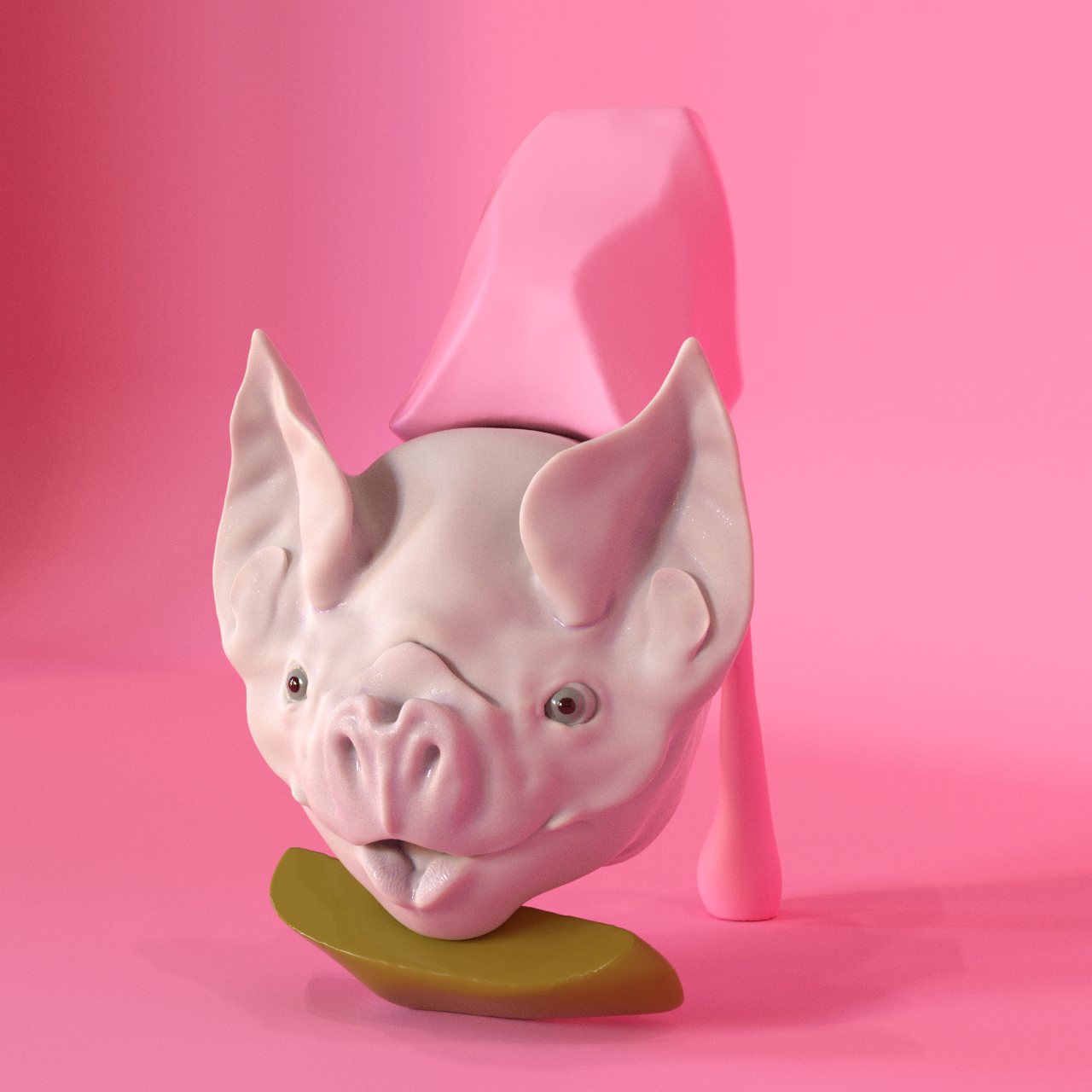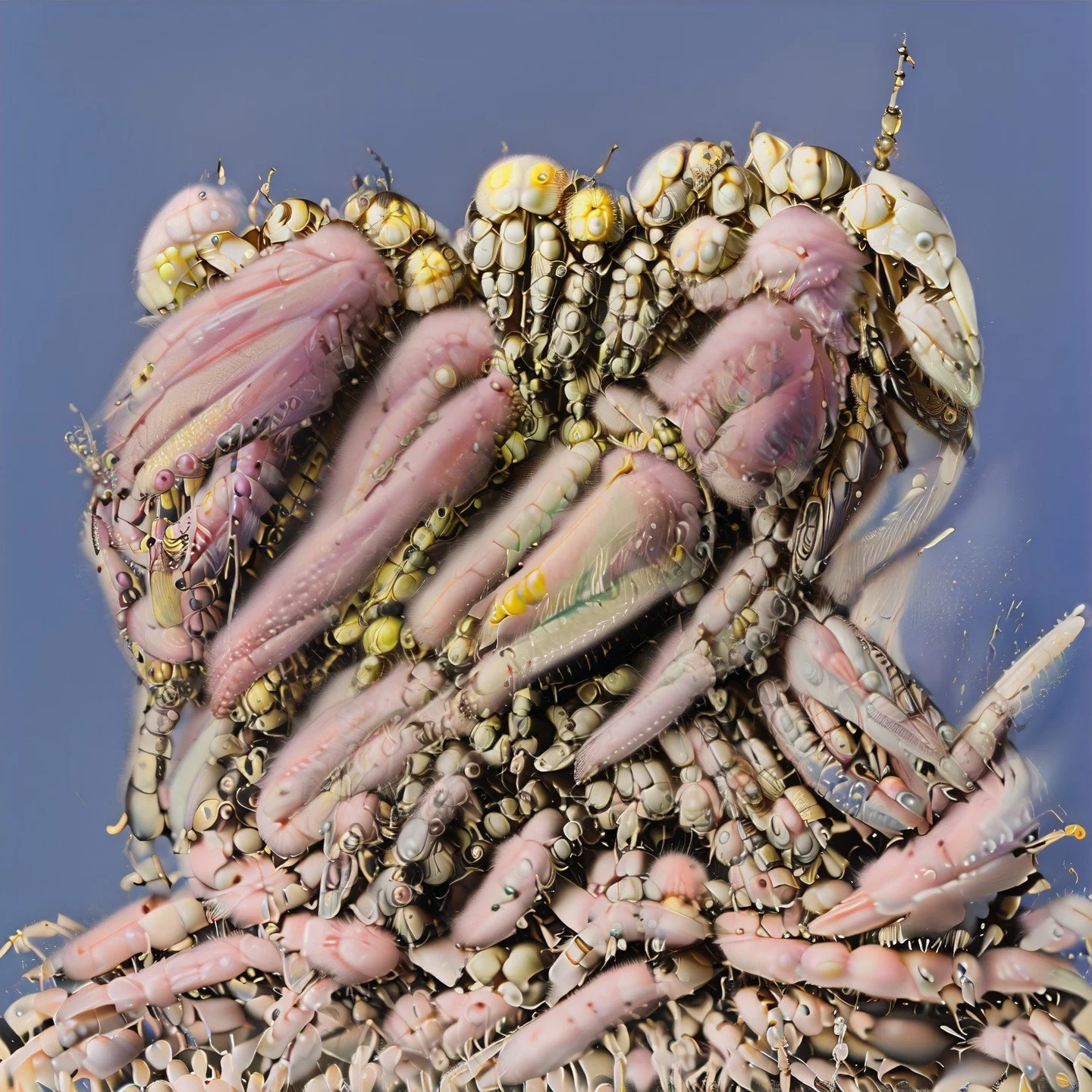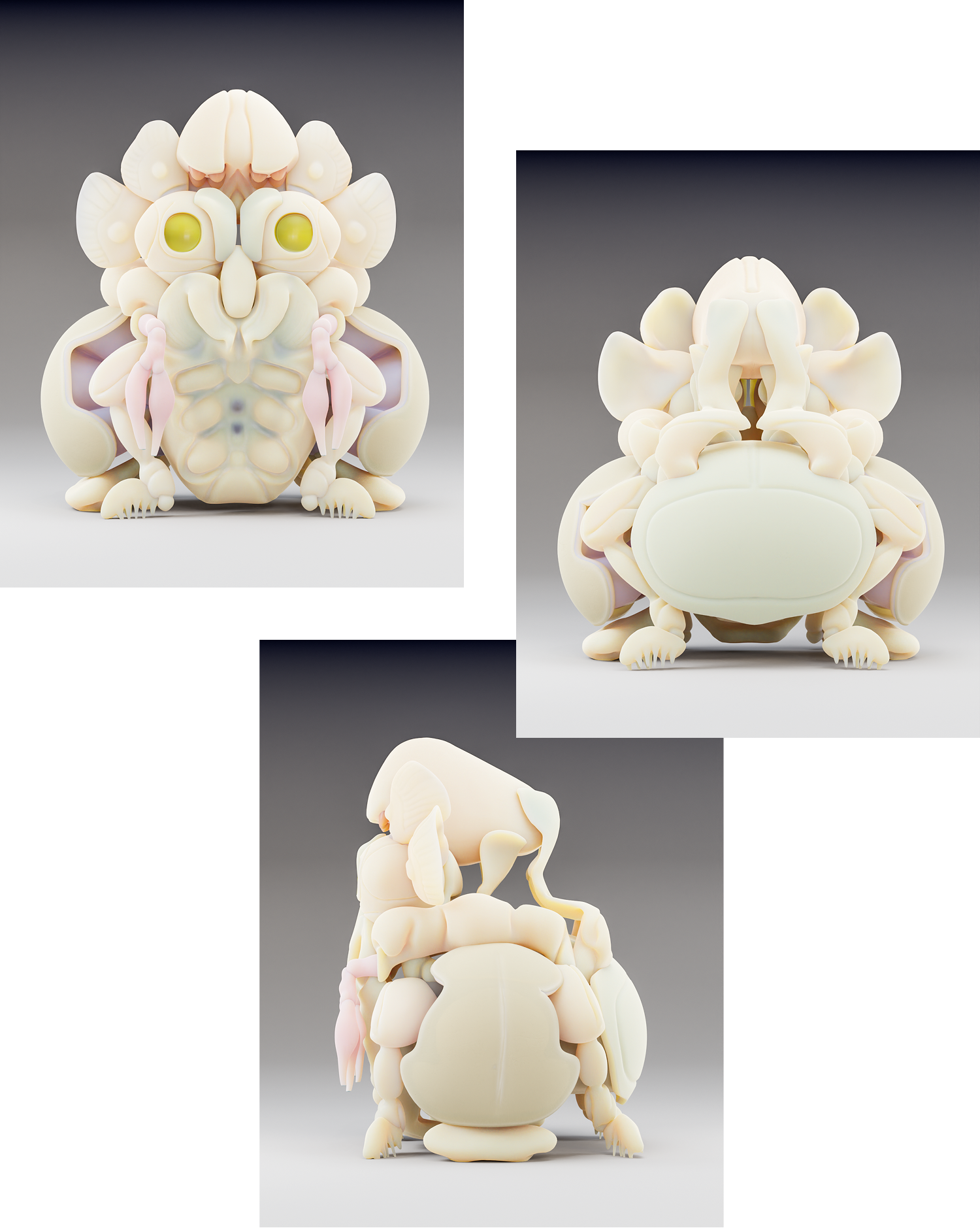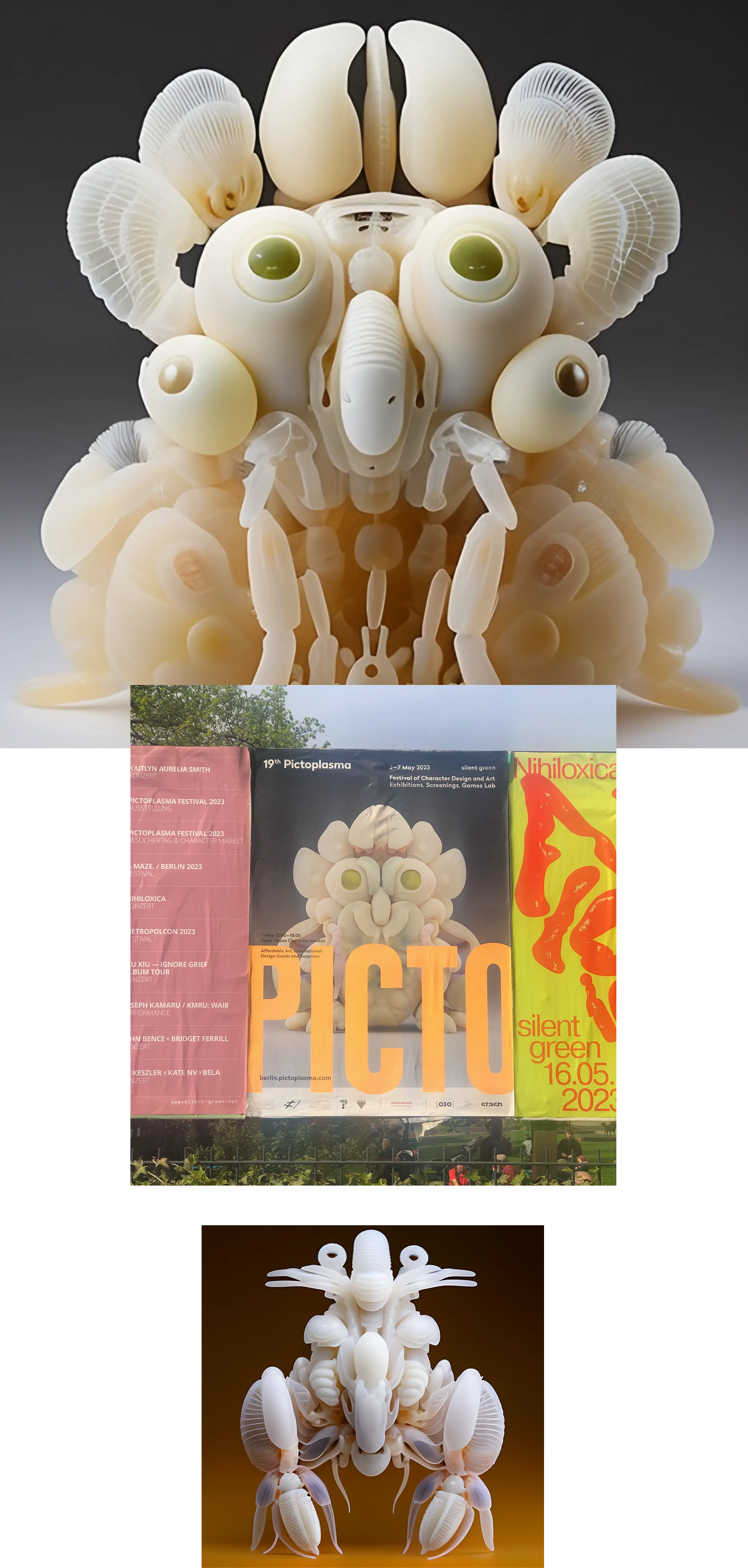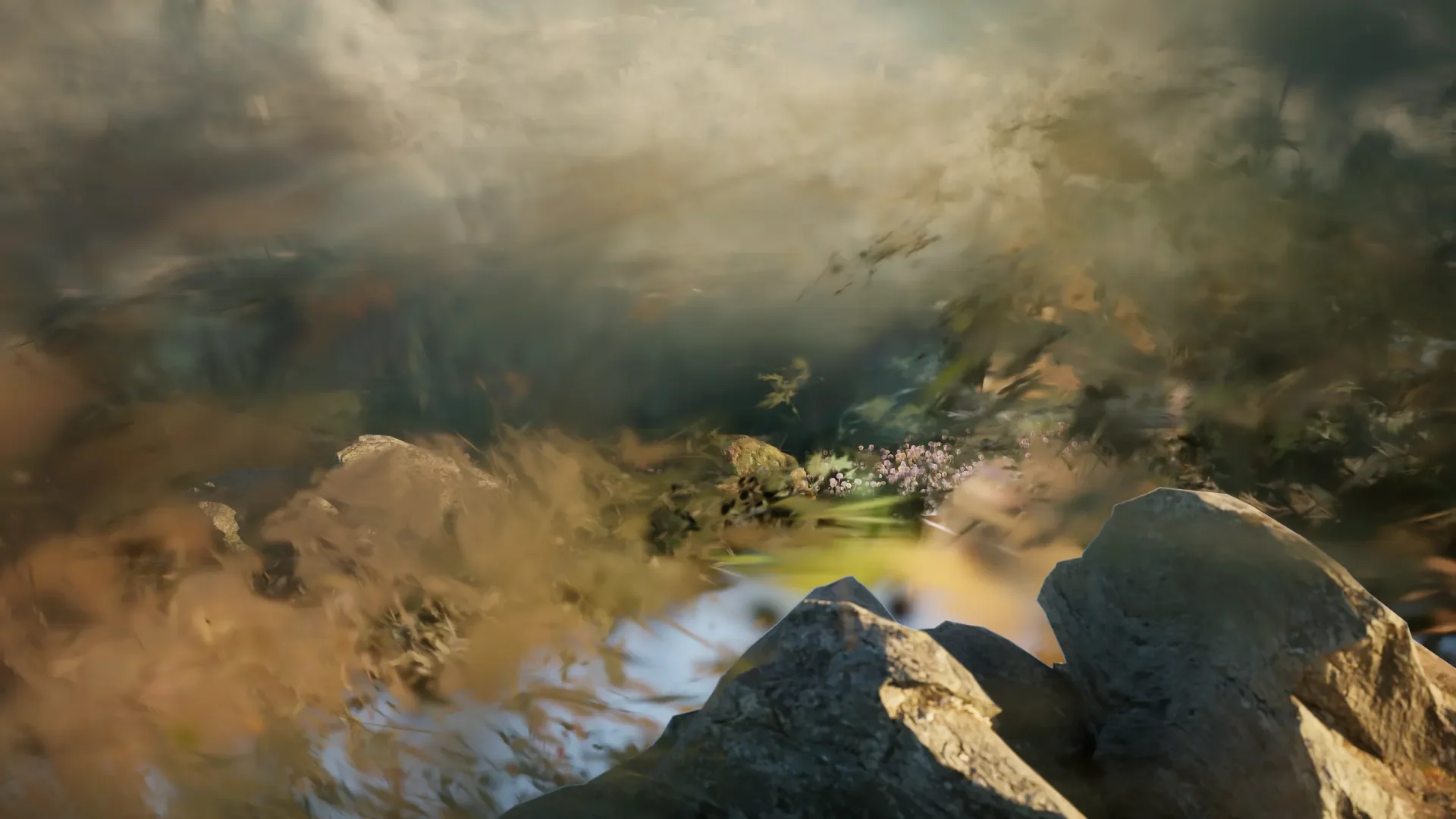The honest machine
A conversation with digital artist Chris Hoffman about building worlds and breaking tools.
By Nando Costa on December, 2025
I've had the pleasure of working with Chris from UglyStupidHonest on a few Microsoft projects over the years, including one where we explored digital avatars and identity.
His one-of-a-kind imagination, seen across his personal projects and in his creative process, kept me hooked, watching him use machine learning not just as a tool, but as a collaborator in creating art that still felt entirely his own.
For this interview, I wanted to talk to him about this shift we are all experiencing with emerging tools, how he is navigating it, as well as what it means to create work that evolves in ways you can’t entirely predict.
I hope you enjoy our conversation.
Can you share what led you to art and design and what your early career days looked like?
Really early on, I was more interested in Biology than anything art-related. If you look closely, you can see that influence in the work I do now. The interest in working on my own visual art came later with skateboarding, the internet, music and sound.
When we got our first computer, I was immediately drawn to all the creative apps. I spent hours in my room learning about them from online forums. These apps were like computer games to me, and maybe still are.
At that time, sound was actually much a bigger interest than the visual side. Back then, I explored programs like Reason, Rebirth, Tracker, later on Logic and Ableton. I still love sound because it’s so immediate, and it does not have as much baggage as visuals. It’s more visceral and emotional because it’s so hard to put it into words. You have to feel it.
My first visual “education” also came from music: I loved album covers and music videos of electronic music acts.
In terms of really getting into the “industry” I got my first internship at Parasol Island where I learned After Effects and Cinema 4D.
I went to Art School in Amsterdam for a bit, learning the conceptual side of thinking about artworks and how to communicate ideas in interesting ways. Later, I worked at Zeitguised via Sehsucht.
The time at Zeitguised was the most influential. I learned so much through working with an incredible crew of absolute geniuses. And in a way, it merged the conceptual art school with the applied commercial side.
What role did those early experiences play in shaping your creative approach today?
I think the most important thing is probably learning how to learn, and understand that you can learn software and tools in a way where you understand the basics that they share and then expand from there. It took me a long time to figure that out.
Always working on side projects experimenting freely and playing with the tools was also key. It still is the core of what Im doing now.
In terms of my visual language I always feel like I approach stuff from a sculptural perspective, where I everything is one closed object and the narrative happens within that object.
I think its the mix of 3D and the sculptural stuff I did in art school, mixed with abstract narration. A world for me does not have to be a landscape or environment as in games and films. I feel like narration and stories can come from a multitude of things. Singular objects empty rooms, sounds. Everything arranged in an interesting way can tell a story without relying on traditional storytelling, which I like.
But doesn’t come naturally in my own work. A narrative for me in essence is a chain of ordered events in sound and image that evokes some kind of emotion or reaction.
“Construgglers” film with foam Studio.
You create these whimsical creatures that inhabit alternate realities, sometimes referring to them as "complex ecosystems."
What gives you energy when you're creating these worlds? Are you most proud of the projects you've created entirely on your own, or the collaborative work you’ve done with others?
I think the interest in biology is a big guide here. When I was young, I was a rock pool (tide pool) child. We went to the seaside in the Netherlands a lot. I always loved rock pools, they are small worlds with all theses incredible creatures. The shapes, colors and the way they interact with each other is still mind blowing to me. Its like watching little aliens living their lives. Again, I prefer seeing the rock pool as one closed object.
There was also an exhibition of Pierre Huyghe I saw in the Pompidou (also on YouTube) that had such a incredible atmosphere. There were all these little scenes that were so moving and interesting. It was both conceptual and entertaining.
To this day its one of my favourite things because it transported me into a totally different world without explaining itself with its intrinsic logic. And it obviously had a lot of animals and other organisms in it 😀
This is what I want to create: an atmosphere that is open enough for the viewer to make it their own, but directed enough to not be random or redundant.
I used to be a bit of a hermit in that I liked to work alone, but now I lean much more towards collaboration. It’s so amazing to tap into the world of someone else and see my world from their perspective.
I don’t have a favourite project. When the project is done, it feels like closure to me: Bye, bye old friend”. Then, I like to move on. Aligning on something with a group and then finishing it is a different sensation than sitting in your own soup all day, eventhough that can be nice too, haha.
In one sentence, the alternative realities are systems I create, and the inhabitants are agents in that system which I don’t fully control. Similar to Brian Eno’s idea of control and surrender in the creative process.
Where does the name UglyStupidHonest come from? There's something beautifully contradictory about choosing such a self-deprecating way to represent work that's clearly sophisticated.
As it often happens with these kinds of names, it's very old haha. I think unconsciously it was an attempt to take the pressure off of myself. Basically saying it might ugly and stupid, but its really what I want to do, explore and learn.
If you think about it, its a process focused name in that way , which still fits. Even though it is maybe a tad dramatic in the way its constructed. 😂
I can sympathize, as my first website in 1998 was called HungryForDesign.com. 😆 Eventually, sometime around the 2010’s or so, I changed to NandoCosta.com and never looked back. Sometimes I wish I hadn’t and kept embrancing the sillyness. We shouldn’t take it all so seriously.
Machine Learning experiments with Creative Commons model trained on his own 3D artwork.
You're one of the first artists I heard about training their own models rather than just using existing ones.
What drew you to this hands-on approach with AI technology, and what made you want to get under the hood rather than just use tools like Midjourney?
Yes, it was a naive play with new technology in a way that I have always done. I’m not a big fan of black boxes in general. If I can, I always want to see how the stuff actually works.
I did that as a child with my brother’s games. I tried to make my own maps or even hack textures in the game. I’m on a constant quest to break tools in the most interesting way and turn them inside out. It is through that process that I learn about the inner workings of the tools.
But obviously, this machine learning stuff was quite low level for me in the beginning, so I had to learn a lot before even being able to do anything. It is all a lot more approachable now. Maybe to its detriment because it no longer invites experimentation in a hacky way. I don’t see the opportunity to hack it as easily because the way theses systems work is so different.
There are LLM hackers like Janus or Pliny that certainly experiment with the models in very interesting ways. I think I tended to these open tools because I could chain them together and build my on system which is what I like to do most.
You gave a talk at OFFF 2023 with Moritz Schwind from Entagma about integrating Stable Diffusion into Houdini pipelines.
For someone with a background where excellence comes from years of mastering complex software and understanding light, form, and character, how do you feel about tools that allow newcomers to replicate similar aesthetics with much less effort?
I try to stay away from investment bias as far as I can because it can trick you into not being open for new ways of working. The key here is replicating. If the tool is used to optimize the production of derivative works of everything that came before, then its not interesting to me at all.
I personally don’t get anything from replicating or rendering reality in detail. Replicating can be interesting from a craft perspective where you learn through replicating, but using black box tools to replicate irradicates this learning process, leaving a hollow experience.
But that said there are people that do new and very interesting things with these tools. I believe they can do this because they have a clear vision of what they want. You could also call it taste.
AI can be a skill multiplier, but it can also be used to make “slop”: derivative fillers that can, in certain circumstances, spin off into a cultural phenomenon, which is then interesting for different reason. A barometer of what is going on across the internet. For instance, this “Italian Brainrot” thing is almost a bit Dada. It reflects on what is liked. If you like it or not and that is interesting in itself.
Often these trendy “slop” things are not interesting to me for a long time, but I would avoid calling them insignificant from some kind of constructed elitist perspective. It’s just something I personally don’t compute with as well.
To answer the question more directly, I did not like replicating something before AI, and I don’t find it interesting with AI. I realize everyone copies to learn but often you are not good at it at first which leads you to a new language that is your own. With some AI tools, I have the feeling the shortcut you take prevents you from developing your own language through failing.
All that said if new comers come up with incredibly intersting stuff with these tools I would love that because it expands culture. Being protective of that would keep me close-minded and preventing me from learning.
Created using the output of a custom fine-tuned model to create a 3D sculpted and rendered creature for Pictoplasma.
Given your active involvement in the AI community and your understanding of how these models work, how do you feel about the integrity of large generative models that were trained on artists' work without consent?
As someone whose own distinctive creature designs could easily be in those training datasets, what's your perspective on this?
This is the tough question. I would love to split the technology and the “market” that formed around it to answer this, but that is not really possible.
I would also not say that I am active in the community. Or instead, let's say I am active in many communities. I’m very interested in it as I am in sound, design, 3D, apps and coding. I don’t want to identify with one thing too much. I’m not an evangelist for any technique. If at all, I’m a evangelist for finding your personal language in whatever you do.
It’s hard for me. I like these technologies because they have these opportunities to build and explore worlds I could not without them. I’m just a nerd in that way. But the way these tools are built is highly problematic to me. Apart from the open source community, they are highly extractive.
I think it all went to fast and worked too well in unexpected ways. All of these models started out as research projects as a goal to find out if they could actually create images or videos. In that sense it, it was not used for commercial purposes. The goal was for systems to understand the world.
That is when I got into the tools because everything they produced was alien and interesting. It was unique and uncanny, and I loved it.
No ChatGPT, not even Midjourney, just obscure Google Collab notebooks. That spoke to be because you had to hack your way through it and everything was free, which obviously is different from today’s subscription models. It was also very different in terms of how data sets were acquired. Today it is a completely different beast.
Datasets are at the center of the models, and while I’m fine with my work being used in them, provided I can reasonably access the model offline, I don’t agree with the data of other people being used without consent.
I’m also not sure about the argument that the data of an individual artist is just a fraction in the grand scheme of things , because the style can be invoked with tokens, drastically influencing the generated image with that artist’s work.
There are things such a public diffusion model that the people from spawning.ai are training which will use only public domain data and opt ins. (Also check out Mitsua-Diffusion-One).
Artwork for Pictoplasma continued.
The main fact however is that these tools coincide with a market that is out for optimization, extraction and automation, and does not concern itself with quality, richness or cultural contribution in most cases.
You have to realize the image and video models have the goal to be world models that eventually power embodied AI-like robots, the “art” usage is a lucky byproduct that they realized can be used to finance a little bit of their way towards their goal. There is no direct interest in art or culture from these companies.
You have grifters and maximizers that waited for these tools to clone and mass produce. All of this probably will end in the destruction of these markets. Because it’s a feedback loop, its like being in a closed room breathing the old air with no fresh air coming in. You will die eventually. The whole thing collapses into one big automator in the long run.
There is an actual thing called “model collapse”, which happens when models eat their own generations. This will eventually happen, eventhough big labs watermark to filter out generation for next training runs. You can already see that with the ads by big companies like Coke and McDonald’s over the past weeks, where they had retract the ads after a lot of backlash.
By contrast, Apple and Intermarche went the other way with a heavily emotional, crafty approach where the actual ad is not as important as the making of, and you can see them pushing these making offs out there with everything they have.
They realize that process can’t be deleted because process IS connection. With open process, the inner-workings lay bare and enable understanding, which strengthens connectionm particularly at a time where the senses are heightened for automation and removing the human.
However, that doesn’t mean that Apple and Intermarche are not automating or using AI. It just means they know how to communicate. A year ago, Apple created ad where they crushed traditional tools to compress them into an iPad Pro. They learned this is not the way because the core of creation is process itself, which is different to for instance sorting an Excel sheet to get to a result. The process there can get deleted and you would not loose precision or quality in the end result.
All of this also has an effect on the brain. It can make you lazy as you are not incentivised to think as much anymore. All those tiny decisions you made before are gone. If you are not careful and build a process around how you work with these tools, you loose your crititcal thinking, which is at the center of what makes you, you.
There is definitely a threshold at which point the model is doing too much for you, and when you struggle to have sufficient influence over the work, losing the process entirely.
I believe this skips a huge range of ideas, surprises and interesting avenues. It is like driving through a city in a fast car as apposed to walking. You might miss incredible things on the way, but your are faster. It’s good to find a balance here. Find the bike in your process. 😊 (which apparently is one of the most efficient ways of getting from one place to the other).
After working with machine learning for a while and closely monitoring the developments. I realized for myself that while I do like the technology, I also like the process of creating and I want to learn while I work like I have always done. I want to be bad at something and then hopefully good. I want to find many hidden gems on the way to get better at something and I dont want to miss those gems by skipping the journey and end up at the goal immediately.
So, while I still like offline versions of the tools for ideas and iterating on ideas and to come up with my own workflows, I try to move away from the online tools especially of the massive labs if I can because there is just too much that I don’t agree with, like the automation craze, the energy issue, the data problem (in terms of scraping) and the lock-in with subscriptions. Ultimately also because they are restrictive blackboxes and don’t foster process and critical thinking.
I want to keep my brain active so I can choose when to collaborate with technology, and only if the majority of the work happens in my or our head. And by majority of work, I don’t always mean the craft in the sense of how many hours did I put in manually, but instead what shaped the work, and does it look like its made by me.
This obviously touches only on the purely generative tools, but there are machine-learning tools that are pure helpers where you can build workflows such as node-based online tools for VFX, making depth maps, normal maps, gaussian splats (something akin to 3D photography), classifiers and much more.
These are much lesser known because they don’t connect with the mainstream like “Ghiblifying” yourself, but those tools are very helpful.
Landscape outputs from model trained on corrupted renders and blurry sketches.
If you had the ability to re-engineer these generative models from scratch, knowing what you know about both the technical and creative sides, what would you have done differently?
How would you approach the training data and artist consent issues?
The easy answer is training on public domain and opt-in data while also staying open source, so everyone can use the models. Plus, doing it all slower, much slower.
The most problematic part is that the power of all these models is sitting in perhaps six big labs, and they are all racing for the throne. That does not feel like a good idea.
I know there are a lot of things happening in the open source world now too, which I love because you can take it apart and hack it. This is what they call a “latent use case”: a software that is stable and designed enough to work for people out of the box, but open and hackable enough for users to find a way to expand the use cases far beyond the original intent.
This circles back to what I said earlier about an artwork being open and designed enough at the same time to give the viewer / user the chance to make it their own.
You're someone who understands both the technical complexity of creating AI tools and the years of work that went into developing the artistic skills they're replicating.
Do you think there's a legitimate positive impact and value in generative image and video tools, even if they were created at the cost of artists' unconsented work?
I think the positive outcome is that they extinguish the attention economy by simply over saturating it with slop, so we can go back to the internet I loved with little websites on geocities.
Back then, you had to make an effort instead of scrolling through a never ending stream of stuff (there are some movements in this direction already, and to a certain extent even within discord and reddit communities.
Again, it’s the market that is the problem. It’s all about maximizing speed, optimizing for being fast for the sake of being fast. Combining these tools with this kind environment is the perfect storm for extracting value as quick as possible.
There are people that create incredibly interesting things, but mostly these works are not about perfectly rendered into beautiful images, they are more about asking questions about the technology and playing with it in unexpected ways.
I’ve recently read a few books that tackle the environmental and social impact of the tech industry’s massive investment on AI infrastructure, and I’ve found it disheartening.
What are your thoughts on that side of the story?
I feel like this is where acceleration and capitalism push the research towards scaling, then only later, with more time, coming up with new architecture that is more efficient.
But the underlying problem is greed, which is especially bad with this technology because its such a big shift, that everyone wants to be the first to get to the ASI. Nothing else matters.
Some of the leaders in that field might be of the opinion that they have to get there first, ahead of their adversaries. And because this is such a big danger the drawbacks we are experiencing are small in their eyes.
I would be completely out of my depth talking about this, as if knowing what is going on in detail. But I feel like everyone should talk to each other more and find common ground and empathy. At the moment it’s often everyone for themselves, which results in power consolidation, which then results in extraction and exploitation.
And I would agree with you this is disheartening and deeply troubling. My hope is that we learn from working together more broadly, and fast, because in my naive mind this is the only way forward.
Experiments with gaussian splatting paintings for Future Deluxe / Forever.
Given your experience training models, working with major tech companies, and seeing the rapid evolution of AI tools, what would you bet on for the next 3 years in this intersection of art, design, and generative tools?
What changes do you think we'll see in how artists work and what gets valued?
I think any bet would be a little bit silly because its so unpredictable. I hope that this race of ai is loosing speed and the hype is dying down so everyone has a chance to actually digaest whats going on. Because there's so much to explore and understand out there already . We don't need so much more every day.
If you were starting your career today, how would you navigate the different tools and social networks? Do you have any advice for incoming artists and designers?
If I would start today without knowing what I know, I would probably panic a bit because of all these overwhelming possibilities threats and the reality of how the world works at the moment.
I don’t feel like I’m the person that should give advice to anyone. But what helped me is staying curious and trying to remain calm in situations where you might feel overwhelmed. I think everyone has a natural compass in themselves, it just often gets drowned out by anxiety ,or maybe feeling the need to work or achieve in a certain way.
The other thing is to find your tribe: people that share a similar way of thinking with. There is nothing more valuable then a community of friends, especially now. I have people I call when I’m struggling, and its the best thing ever. You know who you are 😊.
Collaborate and learn from each other and be ready to adapt. Learn the basics building blocks of whatever you want to do because the technology and tools will change over time but those building blocks stay with you.
Work with every medium you have an interest in, whether digital or not. They all contribute to what will emerge naturally over time: your own “creative language”. If you try to formulate in different mediums, you will see what stays the same, and that is your essence.
Don’t eliminate the process. Don’t specialize if you don’t want to.
All of this is easier said then done, but I think its always worth it to explore.
Comments
Links

